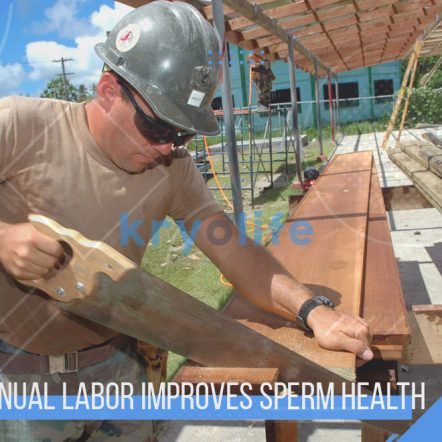Key takeways
- Men with physically demanding jobs have nearly 50% higher sperm counts than those with sedentary office jobs, according to a study by Harvard University and Mass General Brigham.
- Regular physical activity, both at work and during leisure time, is crucial for maintaining and improving male fertility, as supported by numerous studies.
- Further research is needed to explore the underlying mechanisms linking occupational factors and reproductive health, and to raise awareness of the importance of physical activity for male reproductive health.
A recent study by Harvard University and Mass General Brigham has made a surprising discovery: blue-collar workers with physically demanding jobs have almost 50% higher sperm counts than their white-collar counterparts who work in offices.
In this article, we delve into the research, providing insights from experts and examining the potential reasons behind the link between manual labor and better sperm health.
The Study: Investigating the Role of Occupational Factors in Men’s Reproductive Health
Lidia Mínguez-Alarcón, a reproductive epidemiologist and the study’s first author, emphasized the importance of understanding how occupational factors contribute to the known health benefits of exercise.
The study aimed to explore the relationship between physical activity during work and improvements in men’s reproductive potential.
Methodology: Analyzing Semen Samples of Men Seeking Fertility Treatment
Mínguez-Alarcón and her team at Brigham and Women’s Hospital examined 950 semen samples from 377 men who sought fertility treatment between 2005 and 2019.
These samples were collected at the Massachusetts General Hospital Fertility Center.
Participants were asked to self-report their level of physical exertion at work and how often they lifted heavy objects while on the job.
Dr. Lidia Mínguez-Alarcón shared her thoughts on the study’s significance:
“Our findings highlight the importance of considering occupational factors when studying the impact of physical activity on reproductive health. This research opens up new avenues for understanding how job-related physical activity can contribute to improvements in sperm count.”
Participants: A Diverse Mix of Occupations and Physical Exertion Levels
The study had a diverse mix of participants, with various levels of physical exertion at work:
- 76% described their physical exertion at work as “light”
- 12% reported having highly physical jobs
- 9% said they worked evening or rotating shifts
Key Findings: Higher Sperm Counts and Testosterone Levels in Physically Demanding Occupations
The results revealed:
- Men who spent most of their day “lifting or moving heavy objects” had 46% higher sperm concentrations
- Those working evening or rotating shifts had 24% higher testosterone levels than men who only worked during the day
A Surprising Discovery: Increased Estrogen Levels in Occupations with Higher Testosterone
An unexpected finding was that occupations with higher testosterone levels also showed increased estrogen levels.
Researchers believe that excess male hormone was being converted to the female hormone to maintain hormonal balance.
Dr. David Cohen, a renowned endocrinologist, weighed in on this finding:
“The study sheds light on the complex relationship between hormones and occupational factors. It’s fascinating to see how the body adapts to maintain hormonal balance in physically demanding jobs, demonstrating the intricate balance our bodies strive to maintain.”
Context: Taking the General Healthy Population into Account
It’s crucial to note that the 377 participants were already seeking fertility treatment, meaning many of them likely suffered from low sperm counts.
Thus, the results may not be entirely indicative of the general healthy population.
The Positive Impact of Physical Activity on Sperm Count
Several other studies have found that physical activity, not necessarily at work, has a positive impact on sperm count:
- A 2013 Harvard study found that men who exercised for 15 or more hours weekly at a moderate to vigorous rate had a 73% higher sperm count than those who exercised fewer than five hours per week
- A separate study published in 2016 found that just six months of frequent exercise can improve a man’s sperm quality
The Risks of a Sedentary Lifestyle
The 2013 study also found that menwho watched more than 20 hours of TV weekly had a 44% lower sperm count than those who watched almost no TV.
This suggests that a sedentary lifestyle may be detrimental to male fertility.
Dr. Sarah Williams, a fertility expert, commented on these findings:
“While this study focuses on the impact of occupational factors, it’s essential to consider the broader implications of physical activity and sedentary behavior on reproductive health. Men should be mindful of their lifestyles and ensure they incorporate adequate exercise to improve their sperm health.”
Practical Implications: Encouraging Physical Activity for Improved Reproductive Health
Given the study’s results and the growing body of research on the benefits of physical activity for male fertility, it’s evident that incorporating exercise into daily routines is essential for maintaining and improving sperm health.
Some suggestions for incorporating physical activity into daily life include:
- Engaging in regular exercise, such as walking, running, swimming, or weightlifting
- Participating in team sports or group fitness classes
- Taking regular breaks from sitting to stretch or walk around
- Incorporating functional movements into daily tasks, such as gardening or housework
Conclusion: The Need for Further Research and Awareness
The study by Harvard University and Mass General Brigham has shed light on the importance of considering occupational factors when examining the impact of physical activity on male fertility.
As more research explores this area, it becomes increasingly clear that men must prioritize regular physical activity for their reproductive health.
Dr. Lidia Mínguez-Alarcón emphasized the need for continued exploration:
“Our study is just the beginning. We need further research to understand the underlying mechanisms linking occupational factors and reproductive health. As we continue to uncover these connections, we can better inform men about the importance of physical activity in maintaining and improving their sperm health.”
By raising awareness of the connection between physically demanding jobs and higher sperm counts, this research highlights the critical role that lifestyle choices play in reproductive health.
Encouraging men to engage in regular physical activity, whether at work or during their leisure time, will contribute to improved fertility and overall well-being.







